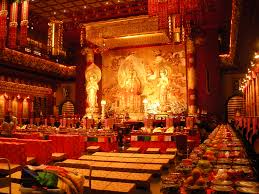Directory
Sacred Temple of the Tooth Relic
Literary sources indicate that the sacred Tooth Relic was received by king Vimaladharmasuriya I with great veneration and placed in the new three – storied shrine built by him near the royal palace. The Dutch Plan of 1765 shows the ground plans of two shrines. The one at the back should be the original one built by the king. His successor was Senarat (1603 – 1634), a brother of the deceased king had to face severe opposition from the contenders. He had to live in such distant places as Mahiyangana. He was able take the Tooth Relic to a safe location at Madamahanuvara in the hills enveloped with thick forest cover. Even under these difficult conditions, king Senarat was able to give due honor to the sacred Tooth Relic by placing it in a suitable shrine. Rajasimha II (1634 – 1686) succeeded king Senarat. As the Portuguese interference in local political affairs was intensified, Rajasimha sought the aid of the Dutch to circumvent the situation.
This action did not meet the approval of the people and a chaotic situation arose again, even to the extent of ceasing the holding of the annual Tooth Relic festival and the king leaving the palace. However he was able to rebuild the sacred Tooth Relic shrine into a two-storied structure and place the Tooth Relic therein. After Rajasimha II, Vimaladharmasuriya II (1686 – 1706) occupied the throne. He was a peace-loving ruler and was able to maintain harmonious relations with the Dutch and attend to many religious activities. The higher ordination of monks was re-established with the help of Burmese monks. He built a new three-storied Relic House for the sacred Tooth Relic. This probably constitutes the structure shown in front in the Dutch Plan of 1765. The king is also credited with the preparation of a grand golden casket for the sacred Tooth Relic and he held great festivities and rituals in honor of the sacred Tooth of the Buddha. Next in line of the ruling house was King Viraparakrama Narendrasimha (1707 – 1739). He was the last Sinhalese king of a long line of rulers and is credited with the protection of the sacred Tooth Relic and ritual honors accorded to the Relic. He rebuilt the Tooth Relic shrine making it two-storied. The chronicle provides a graphic description of the decoration of the shrine with murals of jatakas, etc. At the recent bomb blast of the Tamil Tigers, amidst destruction and devastation of the Dalada Maligava premises, the structure of this shrine known as Vadahitina Maligava was miraculously saved. The falling off of the top plaster of some parts of the walls of the inner shrine has revealed some of the original murals that would belong to the re-builder of the shrine, Narendrasimha.
The next ruler was Sri Vijaya Rajasimha (1738 – 1746) of South Indian Nayakkar origin, who became converted to Buddhism under the influence of Venerable Valvita Saranankara. He was recorded in the Chronicle, Mahavamsa, as having opened the relic casket and seen the sacred Tooth Relic with his own














